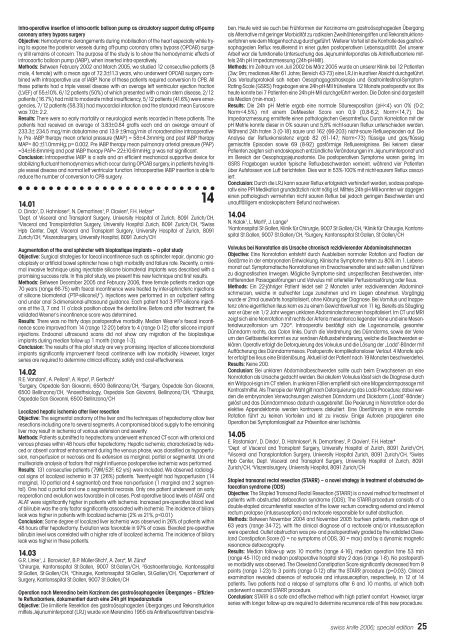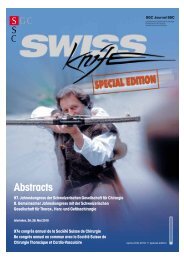Abstracts 4. Gemeinsamer Jahreskongress der ... - SWISS KNIFE
Abstracts 4. Gemeinsamer Jahreskongress der ... - SWISS KNIFE
Abstracts 4. Gemeinsamer Jahreskongress der ... - SWISS KNIFE
Create successful ePaper yourself
Turn your PDF publications into a flip-book with our unique Google optimized e-Paper software.
swissknife spezial 06 12.06.2006 13:39 Uhr Seite 25<br />
Intra-operative insertion of intra-aortic balloon pump as circulatory support during off-pump<br />
coronary artery bypass surgery<br />
Objective: Hemodynamic <strong>der</strong>angements during mobilisation of the heart especially while trying<br />
to expose the posterior vessels during off-pump coronary artery bypass (OPCAB) surgery<br />
still remains of concern. The purpose of the study is to show the hemodynamic effects of<br />
intraoaortic balloon pump (IABP), when inserted intra-operatively.<br />
Methods: Between February 2002 and March 2005, we studied 12 consecutive patients (8<br />
male, 4 female) with a mean age of 72.3±11.3 years, who un<strong>der</strong>went OPCAB surgery combined<br />
with intraoperative use of IABP. None of these patients required conversion to CPB. All<br />
these patients had a triple vessel disease with an average left ventricular ejection fraction<br />
(LVEF) of 55±10%. 6/12 patients (50%) of which presented with a main stem disease, 2/12<br />
patients (16.7%) had mild to mo<strong>der</strong>ate mitral insufficiency, 5/12 patients (41.6%) were emergencies,<br />
7/12 patients (58.3%) had myocardial infarction and the standard mean Euroscore<br />
was 7.0± 2.2.<br />
Results: There were no early mortality or neurological events recorded in these patients. The<br />
patients had received an average of 3.83±0.84 grafts each and an average amount of<br />
233.3± 23<strong>4.</strong>5 mcg/min dobutamine and 13.9 ±9mcg/min of noradrenaline intraoperatively.<br />
Pre -IABP therapy mean arterial pressure (MAP) = 58±<strong>4.</strong>3mmHg and post IABP therapy<br />
MAP= 80 ±11.0mmHg; p= 0.002. Pre IABP therapy mean pulmonary arterial pressure (PAP)<br />
=34±16.6mmHg and post IABP therapy PAP= 22±10.6mmHg; p was not significant.<br />
Conclusion: Intraoperative IABP is a safe and an efficient mechanical supportive device for<br />
stabilizing fluctuant hemodynamics which occur during OPCAB surgery, in patients having triple<br />
vessel disease and normal left ventricular function. Intraoperative IABP insertion is able to<br />
reduce the number of conversion to CPB surgery.<br />
14<br />
1<strong>4.</strong>01<br />
D. Dindo 1 , D. Hahnloser 2 , N. Demartines 1 , P. Clavien 3 , F.H. Hetzer 4<br />
1 Dept. of Visceral and Transplant Surgery, University Hospital of Zurich, 8091 Zurich/CH,<br />
2 Visceral and Transplantation Surgery, University Hospital Zurich, 8091 Zurich/CH, 3 Swiss<br />
Hpb Center, Dept. Visceral and Transplant Surgery, University Hospital of Zurich, 8091<br />
Zurich/CH, 4 Viszeralsurgery, University Hospital, 8091 Zurich/CH<br />
Augmentation of the anal sphincter with bioplastique implants – a pilot study<br />
Objective: Surgical strategies for faecal incontinence such as sphincter repair, dynamic graciloplasty<br />
or artificial bowel sphincter have a high morbidity and failure rate. Recently, a minimal<br />
invasive technique using injectable silicone biomaterial implants was described with a<br />
promising success rate. In this pilot study, we present this new technique and first results.<br />
Methods: Between December 2005 and February 2006, three female patients median age<br />
70 years (range 66-75) with faecal incontinence were treated by inter-sphincteric injections<br />
of silicone biomaterial (PTP-silicone). Injections were performed in an outpatient setting<br />
and un<strong>der</strong> anal 3-dimensional-ultrasound guidance. Each patient had 3 PTP-silicone injections<br />
at the 3, 7 and 11 o’clock position above the dental line. Before and after treatment, the<br />
validated Wexner’s incontinence score was determined.<br />
Results: There was no thirty days postoperative morbidity. Median Wexner’s faecal incontinence<br />
score improved from 14 (range 12-20) before to 4 (range 0-12) after silicone implant<br />
injections. Endoanal ultrasound scans did not show any migration of the bioplastique<br />
implants during median follow-up 1 month (range 1-3).<br />
Conclusion: The results of this pilot study are very promising. Injection of silicone biomaterial<br />
implants significantly improvement faecal continence with low morbidity. However, larger<br />
series are required to determine clinical efficacy, safety and cost-effectiveness.<br />
1<strong>4.</strong>02<br />
R.E. Vandoni 1 , A. Pelloni 2 , A. Krpo 3 , P. Gertsch 4<br />
1 Surgery, Ospedale San Giovanni, 6500 Bellinzona/CH, 2 Surgery, Ospedale San Giovanni,<br />
6500 Bellinzona/CH, 3 Anaesthsiology, Ospedale San Giovanni, Bellinzona/CH, 4 Chirurgia,<br />
Ospedale San Giovanni, 6500 Bellinzona/CH<br />
Localized hepatic ischemia after liver resection<br />
Objective: The segmental anatomy of the liver and the techniques of hepatectomy allow liver<br />
resections including one to several segments. A compromised blood supply to the remaining<br />
liver may result in ischemia of various extension and severity.<br />
Methods: Patients submitted to hepatectomy un<strong>der</strong>went enhanced CT-scan with arterial and<br />
venous phases within 48 hours after hepatectomy. Hepatic ischemia, characterized by reduced<br />
or absent contrast enhancement during the venous phase, was classified as hypoperfusion,<br />
non-perfusion or necrosis and its extension as marginal, partial or segmental. Uni and<br />
multivariate analysis of factors that might influence postoperative ischemia was performed.<br />
Results: 131 consecutive patients (79M/52F, 62 yrs) were included. We observed radiological<br />
signs of localized ischemia in 37 (26%) patients. Twenty-eight had hypoperfusion (14<br />
marginal, 10 partial and 4 segmental) and three non-perfusion (1 marginal and 2 segmental).<br />
One had a partial and one a segmental necrosis. Only one patient un<strong>der</strong>went an early<br />
reoperation and evolution was favorable in all cases. Post-operative blood levels of ASAT and<br />
ALAT were significantly higher in patients with ischemia. Increased pre-operative blood level<br />
of bilirubin was the only factor significantly associated with ischemia. The incidence of biliary<br />
leak was higher in patients with localized ischemia (2% vs 21%, p
















